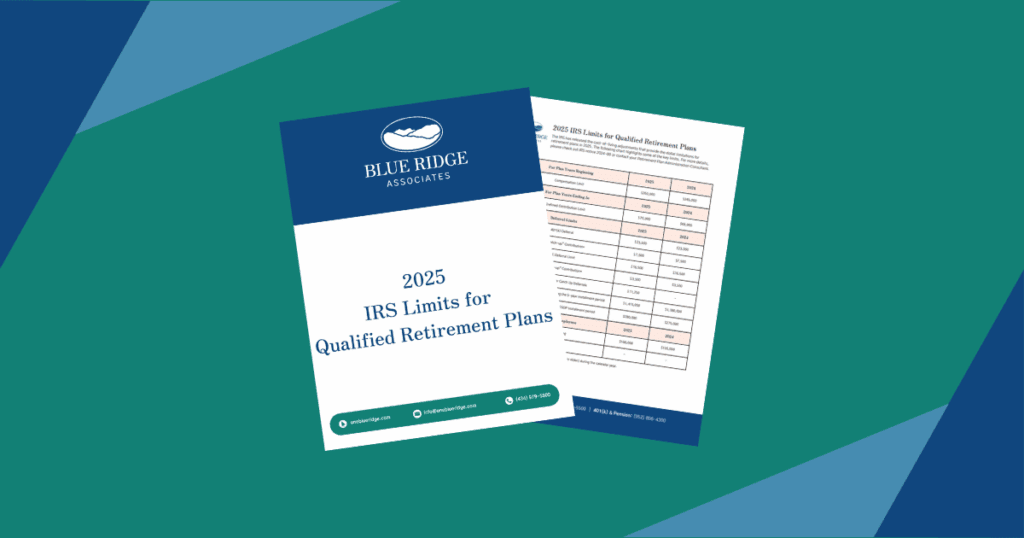Default Provisions and Employer Considerations
As we’ve previously mentioned, the Secure Act 2.0 introduced significant changes to retirement plans. While employers have until December 31, 2026, to formally adopt the amendments, understanding these updates now is important as they can affect the administration of the plan. Below is a summary of key provisions and Blue Ridge’s default treatment of these provisions. If you are interested in implementing or opting out of a certain provision, please contact your Blue Ridge Retirement Plan Administrator.
Age 60-63 Catch-Up Limits
Employees aged 60-63 can now contribute the greater of $10,000 or 150% of the standard catch-up limit for that year, allowing for greater retirement savings during those years. For 2025, that limit is $11,250. This provision will be automatically included and should be made available to eligible employees starting in 2025.
Mandatory Distribution Limit Increase
The involuntary distribution threshold for small account balances has increased from $5,000 to $7,000. This generally means that participants with balances below this limit can have their funds automatically rolled over to an IRA unless they elect another type of distribution. This limit will be increased automatically for employers previously using the $5,000 threshold.
Long-Term Part-Time Employees
Plans must allow employees with at least 500 hours of service in two consecutive years to defer in 401(k) and 403(b) plans, even if these employees don’t satisfy the plan’s standard eligibility requirements. This change is required and will take effect automatically.
Emergency Expense Distributions
Plans can now allow one penalty-free withdrawal of up to $1,000 per year for emergency expenses, with the option to repay within three years. Plans will not include this feature unless elected.
Hardship Distribution Self-Certification
Employers can rely on participant self-certification to confirm that a hardship withdrawal meets IRS requirements, reducing administrative burden. This provision will be available automatically to employers wishing to use self-certification.
Domestic Abuse Distributions
Plans can permit penalty-free withdrawals of up to the lesser of $10,000 or 50% of a participant’s vested account for those experiencing domestic abuse. The distribution must be made within a one-year period beginning any date on which the participant is a victim of domestic abuse by a spouse or domestic partner. Employers can elect to add domestic abuse distributions, but they will not be included by default.
Disaster-Related Distributions
Plans can now offer participants in federally declared disaster areas the ability to take penalty-free withdrawals of up to $22,000 and offer extended loan repayment periods. These options can be added at an employer’s request but will not be automatically included.
Student Loan Matching
Employers can choose to match an employee’s qualified student loan payments as if they were elective deferrals, helping employees with student debt save for retirement. Employers must elect to offer this feature; however, it is not currently supported by all service providers and may not be immediately available.
Roth Treatment of Employer Contributions
Employers may now allow participants to elect Roth treatment for matching and nonelective contributions. Employers must elect to offer this feature; however, it is not currently supported by all service providers.
Automatic Portability
This allows automatic rollovers of small 401(k) balances (under $7,000) when employees change jobs, reducing cash-outs and preserving retirement savings. Again, employers must choose to offer this feature; however, it is not currently supported by all service providers and may not be immediately available.
Pension-Linked Emergency Savings Account
Employers can offer emergency savings accounts linked to their retirement plans, allowing non-highly compensated employees to contribute up to $2,500 in after-tax savings. This feature is not currently available.
Long-Term Care Distributions
Starting in 2026, participants can take penalty-free distributions of up to $2,500 per year to pay for long-term care insurance premiums. Employers must elect to allow this feature.
What’s Next?
Employers should evaluate the new provisions and determine how they align with their needs and goals for the plan. As mentioned, some of these features may not be available at this time.
While the deadline to amend the plan for the Secure Act 2.0 changes is December 31, 2026, these changes may take effect even if the amendment hasn’t been formally adopted. As the document sponsor, Blue Ridge Associates will adopt the necessary amendments on behalf of our clients using the above-mentioned defaults unless otherwise directed.
For more details or assistance in implementing these changes, contact your Blue Ridge Retirement Plan Administrator.



